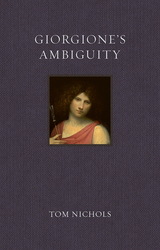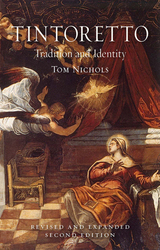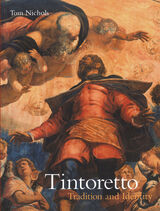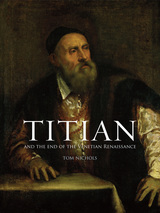4 books about Nichols, Tom

Giorgione’s Ambiguity
Tom Nichols
Reaktion Books, 2021
The Venetian painter known as Giorgione or “big George” died at a young age in the dreadful plague of 1510, possibly having painted fewer than twenty-five works. But many of these are among the most mysterious and alluring in the history of art. Paintings such as The Three Philosophers and The Tempest remain compellingly elusive, seeming to deny the viewer the possibility of interpreting their meaning. Tom Nichols argues that this visual elusiveness was essential to Giorgione’s sensual approach and that ambiguity is the defining quality of his art. Through detailed discussions of all Giorgione’s works, Nichols shows that by abandoning the more intellectual tendencies of much Renaissance art, Giorgione made the world and its meanings appear always more inscrutable.
[more]

Tintoretto
Tradition and Identity
Tom Nichols
Reaktion Books, 2015
Jacopo Tintoretto (1518–94) is an ambiguous figure in the history of art. His radically unorthodox paintings are not readily classifiable, and although he was a Venetian by birth, his standing as a member of the Venetian school is constantly contested. But he was also a formidable maverick, abandoning the humanist narratives and sensuous color palette typical of the great Venetian master, Titian, in favor of a renewed concentration on core Christian subjects painted in a rough and abbreviated chiaroscuro style.
This generously illustrated book offers an extensive analysis of Tintoretto’s greatest paintings, charting his life and work in the context of Venetian art and the culture of the Cinquecento. Tom Nichols shows that Tintoretto was an extraordinarily innovative artist who created a new manner of painting, which, for all of its originality and sophistication, was still able to appeal to the shared emotions of the widest possible audience. This compact, pocket edition features sixteen additional illustrations and a new afterword by the author, and it will continue to be one of the definitive treatments of this once grossly overlooked master.
This generously illustrated book offers an extensive analysis of Tintoretto’s greatest paintings, charting his life and work in the context of Venetian art and the culture of the Cinquecento. Tom Nichols shows that Tintoretto was an extraordinarily innovative artist who created a new manner of painting, which, for all of its originality and sophistication, was still able to appeal to the shared emotions of the widest possible audience. This compact, pocket edition features sixteen additional illustrations and a new afterword by the author, and it will continue to be one of the definitive treatments of this once grossly overlooked master.
[more]

Tintoretto
Tradition and Identity
Tom Nichols
Reaktion Books, 2004
The Venetian painter Jacopo Tintoretto (1518–94) is an ambiguous figure in the history of art. Critics and writers such as Vasari, Ruskin and Sartre all placed him in opposition to the established artistic practice of his time, noting that he had abandoned the values that typified the venerable Venetian Renaissance tradition, even being expelled as an apprentice from the workshop of Titian.
This generously illustrated book offers a long-overdue re-evaluation of Tintoretto. Tom Nichols charts the artist's life and work in the context of Venetian art and the culture of the Cinquecento. He shows how the artist created a new manner of painting, which for all its originality and sophistication made its first appeal to the shared emotions of the widest-possible viewing audience. The book deals extensively with Tintoretto's greatest works, including the paintings at the Scuola di San Rocco in Venice.
This generously illustrated book offers a long-overdue re-evaluation of Tintoretto. Tom Nichols charts the artist's life and work in the context of Venetian art and the culture of the Cinquecento. He shows how the artist created a new manner of painting, which for all its originality and sophistication made its first appeal to the shared emotions of the widest-possible viewing audience. The book deals extensively with Tintoretto's greatest works, including the paintings at the Scuola di San Rocco in Venice.
[more]

Titian
And the End of the Venetian Renaissance
Tom Nichols
Reaktion Books, 2013
Titian is best known for paintings that embodied the tradition of the Venetian Renaissance—but how Venetian was the artist himself? In this study, Tom Nichols probes the tensions between the individualism of Titian’s work and the conservative mores of the city, showing how his art undermined the traditional self-suppressing approach to painting in Venice and reflected his engagement with the individualistic cultures emerging in the courts of early modern Europe.
Ranging widely across Titian’s long career and varied works, Titian and the End of the Venetian Renaissance outlines his radical innovations to the traditional Venetian altarpiece; his transformation of portraits into artistic creations; and his meteoric breakout from the confines of artistic culture in Venice. Nichols explores how Titian challenged the city’s communal values with his competitive professional identity, contending that his intensely personalized way of painting resulted in a departure that effectively brought an end to the Renaissance tradition of painting. Packed with 170 illustrations, this groundbreaking book will change the way people look at Titian and Venetian art history.
Ranging widely across Titian’s long career and varied works, Titian and the End of the Venetian Renaissance outlines his radical innovations to the traditional Venetian altarpiece; his transformation of portraits into artistic creations; and his meteoric breakout from the confines of artistic culture in Venice. Nichols explores how Titian challenged the city’s communal values with his competitive professional identity, contending that his intensely personalized way of painting resulted in a departure that effectively brought an end to the Renaissance tradition of painting. Packed with 170 illustrations, this groundbreaking book will change the way people look at Titian and Venetian art history.
[more]
READERS
Browse our collection.
PUBLISHERS
See BiblioVault's publisher services.
STUDENT SERVICES
Files for college accessibility offices.
UChicago Accessibility Resources
home | accessibility | search | about | contact us
BiblioVault ® 2001 - 2024
The University of Chicago Press









